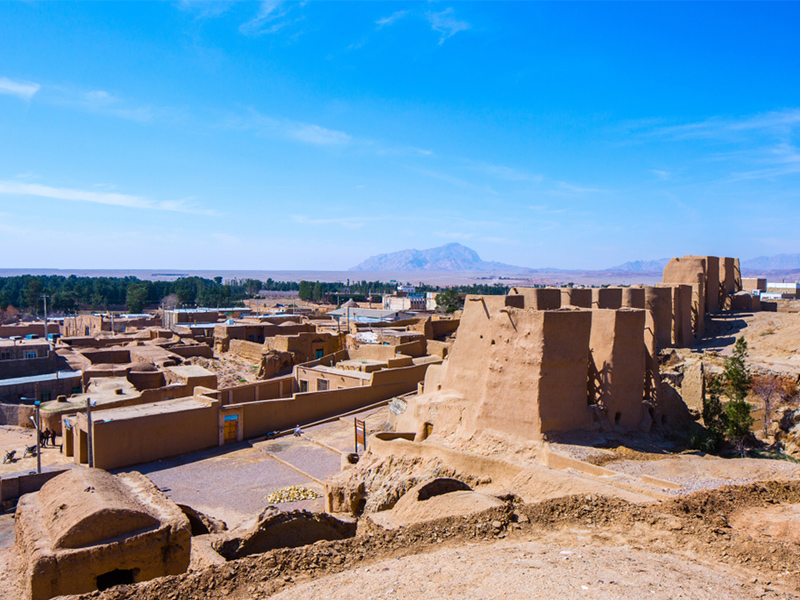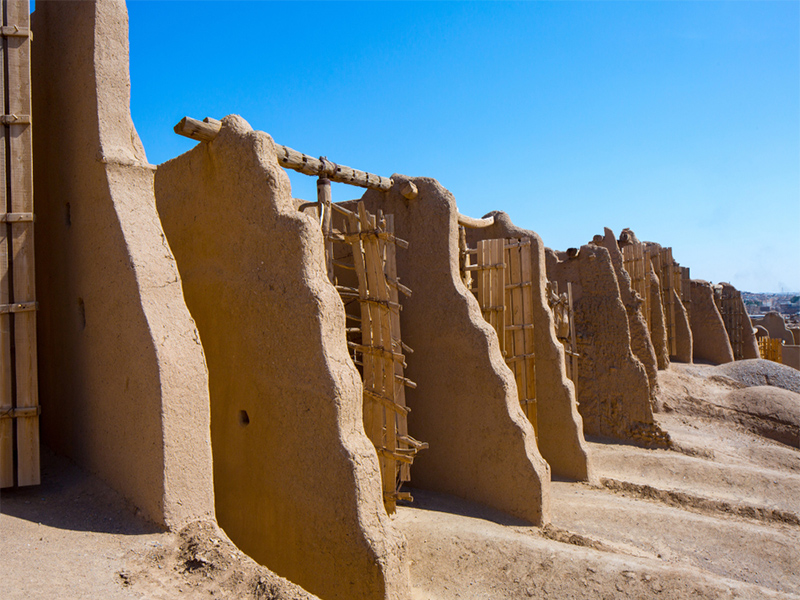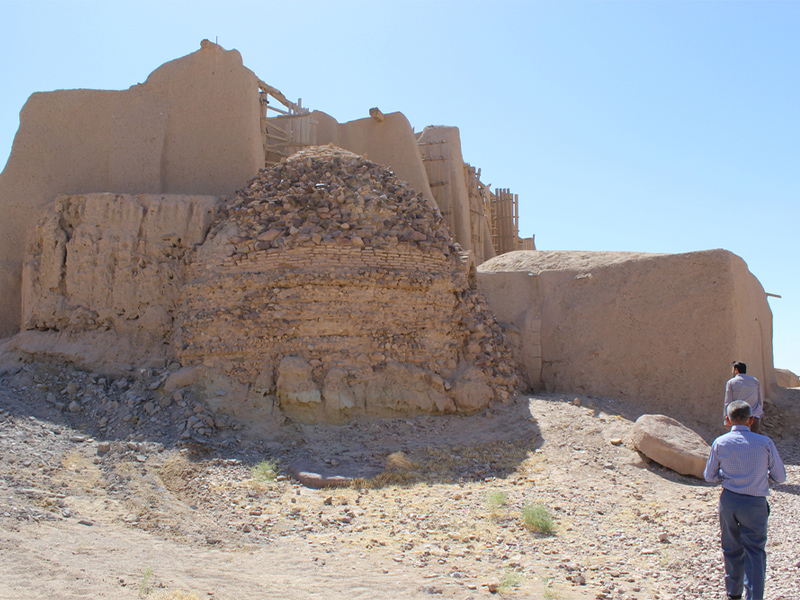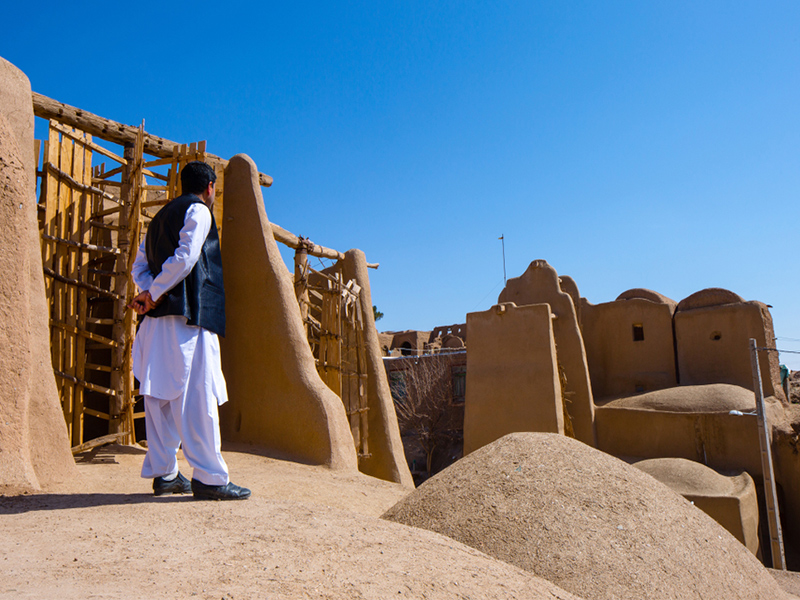The historical complex of the Windmills of Nashtifan, also known as the Windmills of Khaf, is located in Nashtifan, Mashhad, in the province of Khorasan Razavi. It is considered one of the largest collections of historical brick, mud, and wooden structures in Iran, as well as one of the historical windmill complexes in the world that has survived from pre-Islamic times in Iran. This historical complex, with its captivating and fascinating architecture, is counted as one of the significant tourist attractions in this province, visited annually by hundreds of foreign tourists and thousands of domestic tourists. Considering the historical importance of the Windmills of Nashtifan, the General Director of Cultural Heritage, Handicrafts, and Tourism of Khorasan Razavi has stated in official news agencies that these historical artifacts are scheduled to be submitted for UNESCO World Heritage List registration. Continuing with Eligasht magazine, we will provide you with the necessary information about the Windmills of Khaf and the expectations for the registration of this historical site in the UNESCO World Heritage List.
Book Iran Air flights from London to Tehran and Tehran to London with Eligasht UK:
The Windmills of Nashtifan in Khorasan Razavi
As mentioned above, the Windmills of Nashtifan is a historical complex located in Khorasan Razavi Province that, due to its historical and unique features, is awaiting registration in the UNESCO World Heritage List. This historical complex is located in the city of Nashtifan, which has been famous among the public with the same name for the past six centuries. It is mentioned in the writings of Samarkandi that Al-Muzaffar, one of the Iranian kings and rulers from Nashtifan, ruled over Shiraz and Fars for many years. During his rule, numerous intellectuals and poets such as Hafez became immortalized in the history of Iran, and the city of Nashtifan became renowned in the early 9th century and flourished. One of the reasons that make this city historically significant is the Zoroastrian-style tombs located around the city, with some locals believing that some of these tombs are the burial sites of the offspring and descendants of the Arsacid dynasty, while others believe that in the past, they were buried in the outskirts of the city to protect it from potential attacks and invasions, signifying the authenticity and integrity of its people. The Jameh Mosque of the city, founded by the attention of Sheikh Zein ol-Din Khafi and by the order of Pir Ahmad Khafi, has also become one of the precious ancient artifacts despite its use by the locals, serving as a testament to the cultural importance of this city in not-so-distant past.

Reason for Naming the Windmills ” Nashtifan”
There is some information about the origin of the name ” Nashtifan ” that tells a popular story within the city itself. The name of this city is a combination of two words: “Nish,” a local term for scorpion, as the desert regions are abundant with this creature, and “Tifan,” which has become a local term for “storm” and encompasses the seasonal winds that blow in the region of Nashtifan throughout the year. Due to the geographical conditions of the Nashtifan region, its inhabitants have been contemplating the utilization of these natural conditions since ancient times, using windmills to harness the kinetic energy of the winds for grinding wheat into flour. This engineering masterpiece has also been used in other applications such as water pumping, known as wind pumps.
It should be noted that there is no precise information about the emergence of these windmills or Nashtifan windmills in Khaf. However, historians have mentioned their antiquity dating back to before the Muslim conquest of Iran, and some have even associated them with 1700 years before Christ.
Related post
Untamed Beauty: Witnessing the Raw Magnificence of Deserts in Iran
The sights of the Karakal Desert in Yazd will leave you amazed!
Architecture and Functionality of the Windmills
Design and construction
The windmills of Nashtifan are made primarily of clay, straw, and wood. Their design is simple yet effective, consisting of a vertical axis with rotating blades that catch the wind’s force. The use of local materials and traditional construction techniques allowed the windmills to withstand the test of time.
Grinding mechanism
The windmills were primarily used for grinding grain into flour. The rotating blades, when caught by the wind, would transfer their kinetic energy to a grinding stone inside the structure. This stone would crush the grain into fine powder, ready for use in baking and cooking.

Windmill clusters and irrigation systems
The windmills of Nashtifan were not standalone structures but formed clusters, strategically positioned to maximize wind efficiency. These clusters were often accompanied by intricate irrigation systems that helped channel water to the surrounding fields, ensuring sustainable agriculture in the arid desert environment.
Description of the Nashtifan Windmills in Khaf
Although complete and accurate information about the Nashtifan windmills in Khaf is not available, according to the historical geography book of the Zaveh province, it is described as follows:
It consists of a gigantic wheel with 48 wings and 32 blades, placed on the roof of the windmill by the wind direction. The structure of this wheel and blades is made of heavy and sturdy woodwork, and as the wind passes through an eight-gated wind catcher, it reaches the wheel and blades, setting them in motion. The movement of the wheel and blades transfers force to a mill shaft, which is connected to a grinding stone. As the stone rotates, it causes a small wooden device called “Laklaki” to swing, and the movement of the Laklaki vibrates two wooden arms that scoop wheat from the wheat hopper. These arms slowly guide the wheat horizontally from the wheat hopper to the central cavity of the grinding stone. Naturally, the faster the wind blows, the faster the stone rotates, and as the stone spins rapidly, the movement of the Laklaki and the vibration of the arms bring a larger amount of wheat into the grinding stones.
The Nashtifan Windmill is a system that, despite its simplicity, has proven to be efficient and utilizes natural resources without incurring additional costs. Windmills, compared to modern industrial mills, do not cause pollution and do not disrupt the balance and cycle of nature, which is something worth contemplating in modern human life.

Access to the Nashtifan Windmills in Khaf:
Best time to visit: From April to autumn.
Important areas to visit: Nashtifan Windmills, the city of Khaf, Sanganeh, the villages of Barabad, Tizab, Khargerd, and Mehraabad.
Address: Khorasan Razavi, Khaf, Nashtifan.
Some interesting facts about the Nashtifan Windmills in Khaf:
- It can be confidently stated that the Nashtifan Windmills are considered a historical example of Iran dating back to the time of Ibn Khaldun, with a historical background that predates Islam.
- The Nashtifan windmills were built during the Safavid period in Khorasan Razavi province and have remained intact since then.
- The structure of the Nashtifan windmills has a unique architecture and differs from other rotating windmills.
- The main source of energy for the Nashtifan Windmills is the 120-day wind of Sistan, which not only affects these windmills during that period but also has its effects throughout the year. Other winds, such as the Nishabud wind, also contribute to the operation of these windmills.
- The 120-day winds of Sistan blow during the warm season from April to autumn and originate from the snow-capped mountains of Mount Baba in Hindukush.
- There is a cavity underneath the stones where an ancient and primitive device is located that, based on the lever mechanism, can immobilize the stones when necessary instead of using brakes.
- In the windmills, there is a tool called the “Takht-e-Vahshat” that slows down the movement of the stones from below and inside the mill. Immediately after that, another lever called the “Nibad” completely immobilizes the wheel and wings upwards, and the operation ceases.
- Approximately 40 windmills of the Nashtifan system in Khaf are still preserved, creating a unique and unparalleled landscape.
As mentioned at the beginning of the text, the historical and valuable collection of Nashtifan in Khaf is awaiting registration on the UNESCO World Heritage List.
The head of the Cultural Heritage in Khorasan Razavi, South Khorasan, and Sistan and Baluchestan mentioned the final stages of the documentation and mapping operations of Nashtifan in Khaf for global registration. He stated that the documentary process is underway by the Cultural Heritage Base of Asbad in Iran to prepare a comprehensive file for the registration of Iranian windmills in the World Heritage List.

Final words
In this article from Eligasht, we introduced the ancient windmills of Nashtifan. This place can stand as a remarkable testament to human ingenuity and harmonious coexistence with nature. These timeless structures, dating back to the Safavid period, have withstood the test of time, continuing to harness the power of the winds that sweep through the region. The Nashtifan windmills, with their distinctive architecture and ingenious mechanisms, provide a glimpse into the rich history and cultural heritage of Khaf in Khorasan Razavi province. Beyond their functional purpose, these windmills evoke a sense of awe and admiration for the craftsmanship and engineering prowess of their creators. Each windmill stands tall, a silent sentinel that has witnessed generations come and go, while faithfully serving its purpose. The anticipation of Nashtifan windmills being registered on the UNESCO World Heritage List adds to their significance. It recognizes their universal value and the need to preserve these living relics for future generations to appreciate and learn from.

